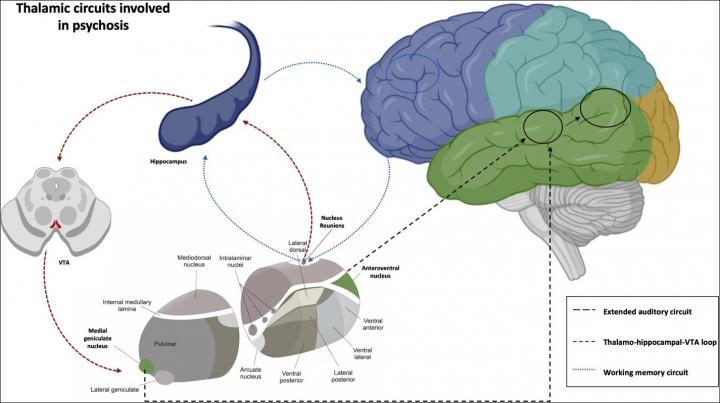Schizophrenia symptom may be the result of increased connections between sensory and language-processing brain areas

Credit: Elsevier, 2020 (Creative Commons license, CC-BY)
Philadelphia, June 30, 2020 – Auditory hallucinations, a phenomenon in which people hear voices or other sounds in the absence of external stimuli, are a feature of schizophrenia and some other neuropsychiatric disorders. How they arise in the brain has been unclear, but new research indicates that altered brain connectivity between sensory and cognitive processing areas may be responsible.
The study from researchers led by Stephan Eliez, MD, PhD, at Geneva University, Switzerland, appears in Biological Psychiatry: Cognitive Neuroscience and Neuroimaging, published by Elsevier.
“Our results demonstrate aberrant development of the thalamic nuclei involved in sensory processing and [an] immature pattern of thalamo-cortical connectivity to the brain’s auditory regions,” said lead author Valentina Mancini, MD.
Using magnetic resonance imaging (MRI), the researchers compared brain structures and their connectivity in 110 healthy control subjects and in 120 subjects with a genetic disorder, named 22q11.2 deletion syndrome, or DS. People with 22q11.2 DS are at far higher risk than the general public to develop schizophrenia and to experience sensory hallucinations. An estimated one percent of people with schizophrenia have this disorder.
Abnormalities in the thalamus, a brain region recognized as the “gateway” for sensory information coming into the brain, had already been implicated in schizophrenia and hallucinations. In the current study, the authors sought to parse more specifically how the thalamus and its connections to other brain areas differed in people with 22q11.2 DS – with and without auditory hallucinations (AH) – from the control group. For this longitudinal study, the researchers collected brain scans every three years from subjects aged 8 to 35, with each receiving between 1 and 4 scans.
While neither the total volume of the thalamus nor its developmental growth trajectory differed between 22q11.2 DS and control subjects, the researchers found differences in specific thalamic sub-nuclei. The medial and lateral geniculate nuclei (MGN, LGN), which are involved in relaying auditory and visual sensory information, were smaller in people with 22q11.2 DS. In contrast, thalamic nuclei that communicate with the frontal cortex, which is involved in higher cognitive functions, were larger in 22q11.2 DS subjects than in healthy controls. In addition, other thalamic nuclei developed differently in the two groups.
When comparing 22q11.2 DS subjects with and without AH, those with AH had a smaller volume of MGN and a different developmental trajectory.
Upon assessing functional connectivity within the brain, the authors also found that subjects with AH had greater connectivity between MGN with the auditory cortex and other language-processing areas. They postulate that such hyper-connectivity might underlie the activation of such auditory areas at rest, leading to hallucinations.
“These findings provide a mechanistic explanation to the extreme likelihood of hallucinatory phenomena in youths prone to psychosis due to 22q11.2 deletion syndrome,” Dr. Mancini added. “Further, the investigation of the developmental interactions between the thalamus and the cortex may help to identify new targets for intervention aimed at preventing the emergence of psychotic symptoms in individuals at-risk due to genetic conditions or clinical ultra-high-risk status.”
Cameron Carter, MD, Editor of Biological Psychiatry: Cognitive Neuroscience and Neuroimaging added: “This study of individuals with 22q11 may provide a unique window into the alterations in brain development that underlie the development of psychotic symptoms, as well as other developmental and cognitive problems in these young people.”
###
Notes for editors
The article is “Abnormal development and dysconnectivity of distinct thalamic nuclei in patients with22q11.2 deletion syndrome experiencing auditory hallucinations,” by Valentina Mancini, Daniela Zöller, Maude Schneider, Marie Schaer, and Stephan Eliez (https:/
Copies of this paper are available to credentialed journalists upon request; please contact Rhiannon Bugno at [email protected]”>[email protected] or +1 254 522 9700. Journalists wishing to interview the authors may contact Valentina Mancini, MD, at [email protected]”>[email protected] or +41 0223 791 228.
The authors’ affiliations and disclosures of financial and conflicts of interests are available in the article.
Cameron S. Carter, MD, is Professor of Psychiatry and Psychology and Director of the Center for Neuroscience at the University of California, Davis. His disclosures of financial and conflicts of interests are available here.
About Biological Psychiatry: Cognitive Neuroscience and Neuroimaging
Biological Psychiatry: Cognitive Neuroscience and Neuroimaging is an official journal of the Society of Biological Psychiatry, whose purpose is to promote excellence in scientific research and education in fields that investigate the nature, causes, mechanisms and treatments of disorders of thought, emotion, or behavior. In accord with this mission, this peer-reviewed, rapid-publication, international journal focuses on studies using the tools and constructs of cognitive neuroscience, including the full range of non-invasive neuroimaging and human extra- and intracranial physiological recording methodologies. It publishes both basic and clinical studies, including those that incorporate genetic data, pharmacological challenges, and computational modeling approaches. http://www.
About Elsevier
Elsevier is a global information analytics business that helps scientists and clinicians to find new answers, reshape human knowledge, and tackle the most urgent human crises. For 140 years, we have partnered with the research world to curate and verify scientific knowledge. Today, we’re committed to bringing that rigor to a new generation of platforms. Elsevier provides digital solutions and tools in the areas of strategic research management, R&D performance, clinical decision support, and professional education; including ScienceDirect, Scopus, SciVal, ClinicalKey and Sherpath. Elsevier publishes over 2,500 digitized journals, including The Lancet and Cell, 39,000 e-book titles and many iconic reference works, including Gray’s Anatomy. Elsevier is part of RELX, a global provider of information-based analytics and decision tools for professional and business customers. http://www.
Media contact
Rhiannon Bugno, Editorial Office
Biological Psychiatry: Cognitive Neuroscience and Neuroimaging
+1 254 522 9700
[email protected]”>[email protected]
Media Contact
Rhiannon Bugno
[email protected]
Original Source
https:/
Related Journal Article
http://dx.




